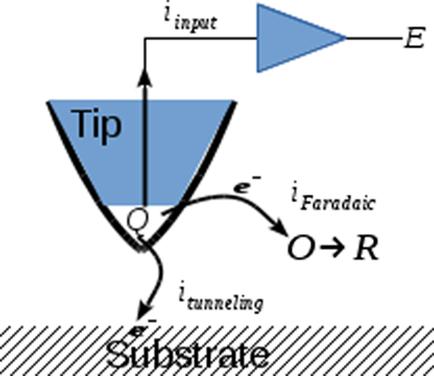当前位置:
X-MOL 学术
›
ChemElectroChem
›
论文详情
Our official English website, www.x-mol.net, welcomes your
feedback! (Note: you will need to create a separate account there.)
On the Mechanism of Scanning Electrochemical Potential Microscopy
ChemElectroChem ( IF 3.5 ) Pub Date : 2017-10-16 , DOI: 10.1002/celc.201701031 Jochen Friedl 1 , Jingying Gu 1 , Ulrich Stimming 1 , Benjamin R. Horrocks 1
ChemElectroChem ( IF 3.5 ) Pub Date : 2017-10-16 , DOI: 10.1002/celc.201701031 Jochen Friedl 1 , Jingying Gu 1 , Ulrich Stimming 1 , Benjamin R. Horrocks 1
Affiliation

|
Scanning electrochemical potential microscopy (SECPM) is a type of probe microscopy, in which a sharp tip similar to those employed in electrochemical tunnelling microscopy is connected to a high impedance amplifier, but the tip potential instead of tip current is used as the signal in the feedback loop. SECPM has been found to provide much higher spatial resolution than would be expected on the basis of a mechanism in which the tip responds to the local electrochemical potential of the solution; in fact, it can obtain atomic resolution similar to STM, but is a superior technique for imaging electronically insulating objects such as proteins on a metal surface. We suggest a mechanism for these high‐resolution images based on electron exchange between tip and substrate coupled to faradaic processes at the tip/solution interface. This mechanism operates alongside the conventional mechanism in which the tip responds to the local potential in the diffuse layer of the substrate and allows a simple description of the sigmoidal tip potential−distance curves that have been reported.
中文翻译:

扫描电势显微镜的机理
扫描电化学势显微镜(SECPM)是一种探针显微镜,其中与电化学隧穿显微镜相似的尖锐尖端连接到高阻抗放大器,但尖端电位代替尖端电流用作信号。反馈回路。已经发现,SECPM可提供比根据尖端对溶液的局部电化学势作出反应的机理所期望的空间分辨率高得多的空间分辨率。实际上,它可以获得类似于STM的原子分辨率,但是它是一种用于对金属表面上的电子绝缘对象(例如蛋白质)成像的高级技术。我们提出了一种基于尖端和底物之间电子交换的机制,这些机制是基于尖端/溶液界面上的法拉第过程的电子交换。
更新日期:2017-10-16
中文翻译:

扫描电势显微镜的机理
扫描电化学势显微镜(SECPM)是一种探针显微镜,其中与电化学隧穿显微镜相似的尖锐尖端连接到高阻抗放大器,但尖端电位代替尖端电流用作信号。反馈回路。已经发现,SECPM可提供比根据尖端对溶液的局部电化学势作出反应的机理所期望的空间分辨率高得多的空间分辨率。实际上,它可以获得类似于STM的原子分辨率,但是它是一种用于对金属表面上的电子绝缘对象(例如蛋白质)成像的高级技术。我们提出了一种基于尖端和底物之间电子交换的机制,这些机制是基于尖端/溶液界面上的法拉第过程的电子交换。











































 京公网安备 11010802027423号
京公网安备 11010802027423号